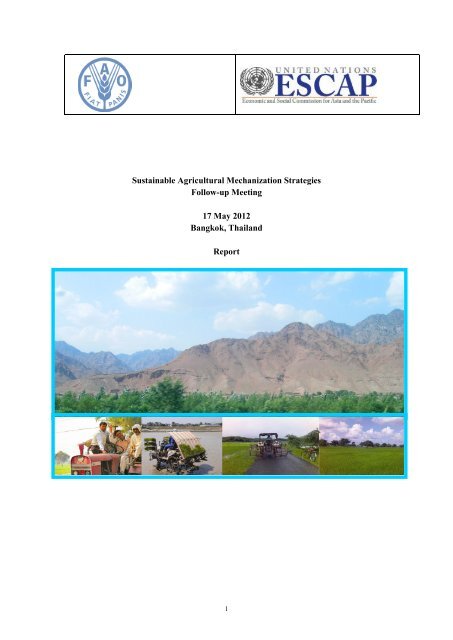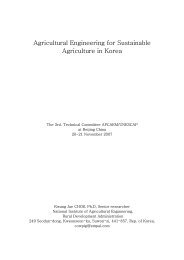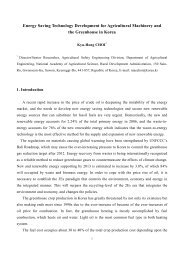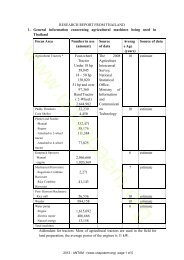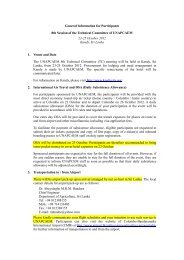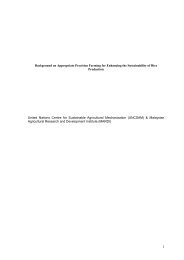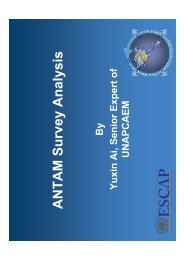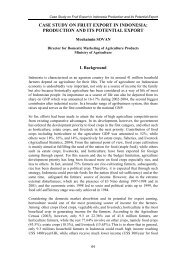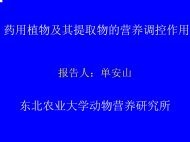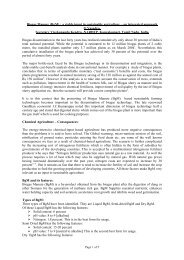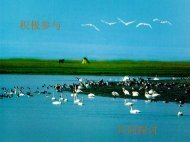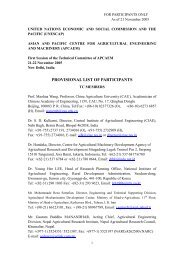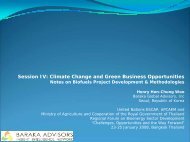SAMS Follow-up Meeting Report
SAMS Follow-up Meeting Report
SAMS Follow-up Meeting Report
You also want an ePaper? Increase the reach of your titles
YUMPU automatically turns print PDFs into web optimized ePapers that Google loves.
Sustainable Agricultural Mechanization Strategies<strong>Follow</strong>-<strong>up</strong> <strong>Meeting</strong>17 May 2012Bangkok, Thailand<strong>Report</strong>1
Executive SummaryOn 17 May 2012, a Sustainable Agricultural Mechanization Strategy (<strong>SAMS</strong>)<strong>Meeting</strong> was jointly convened by the United Nations Food and AgricultureOrganization (FAO) and the United Nations Asian and Pacific Centre for AgriculturalEngineering and Machinery (UNAPCAEM) This May meeting served as an initialfollow-<strong>up</strong> to the <strong>SAMS</strong> Roundtable held December 2011 at FAO’s Regional Officefor Asia-Pacific. The Roundtable, which established a platform for increasedsubstantive collaboration and tangible action on <strong>SAMS</strong> between FAO andUNAPCAEM, addressed the modalities in developing Sustainable AgriculturalMechanization Strategies (<strong>SAMS</strong>) that can enable countries to achieve the dual goalsof intensifying agricultural production and achieving environmental sustainability.The latter is particularly important for the Asia-Pacific region, which is alreadybeginning to face serious environmental challenges to maintain its agriculturalproduction base.The <strong>SAMS</strong> Roundtable also created a <strong>SAMS</strong> Framework with the overall strategicgoal “To address the UN Millennium Development Goals No. 1 and 7 (food security,poverty alleviation, and environmental sustainability) through sustainableintensification of agriculture by creating an enabling environment through a <strong>SAMS</strong>for the Region.” This goal will be met through activities under five major strategicpillars:- Surveys, assessments and analyses of the current status of agriculturalmechanization- Enabling policies and institutions- Human capacity development- Financial s<strong>up</strong>port to enhance investment in <strong>SAMS</strong>.- Advocacy on sustainable agricultural mechanization.The <strong>SAMS</strong> framework is not an end in itself but rather marks the beginning of along-term approach. Thus, this first post Roundtable meeting called on countryparticipants to develop an outline under strategic pillar 1. After a day of gro<strong>up</strong> work,countries agreed <strong>up</strong>on 7 key areas to gather information on from their respectivecountry ministries including: General data Existing agricultural practices Machinery s<strong>up</strong>ply chains Policies that are relevant to/cover SAM Institutional linkages (intra-, inter-) SAM related Existing human capacity for <strong>SAMS</strong>2
Emerging innovative schemes with implications for <strong>SAMS</strong>The <strong>Meeting</strong> was attended by country representatives in the area of agriculturalmechanization from Bangladesh, China, India, Indonesia, Malaysia, Mongolia, PapuaNew Guinea, Philippines, Russian Federation, Thailand, Sri Lanka, and Viet Nam,with all countries agreeing to share and present their findings at the next <strong>SAMS</strong>activity to be held in Sri Lanka from 23-25 October 2012.3
TABLE OF CONTENTSExecutive Summary 2Introduction 3List of Annexes1. Pillar 1 52. <strong>Meeting</strong> agenda 83. 17 May participant list 104. Project Concept Note: Mechanizing intercropping 1 systems forthe sustainable intensification of agriculture and poverty reduction 14IntroductionWhy <strong>SAMS</strong>?The development of sustainable agricultural mechanization strategies has animportant role to play in climate change and food security via reducing the impact onfragile natural resources and increasing farming’s resiliency in the face of acceleratingerratic weather such as prolonged drought events. With a <strong>SAMS</strong> in place, a countrycan choose the most sustainable path toward intensifying its agricultural production.Agricultural mechanization is a key factor in the world’s ability to feed itself andrapid mechanization in agriculture has allowed the sector to keep <strong>up</strong> with the demandsof population, particularly in the Asia-Pacific Region, despite the fact that the totallabour force involved in agricultural activities is experiencing annual declines.However, current agricultural mechanization practices have increased pressure onfragile natural resources, such as increasing soil erosion and promoting overuse ofchemical inputs, the latter seen in heavy utilization of synthetic nitrogen fertilizers incrop production typically resulting in significantly more nitrous oxide (N2O)emissions from agricultural soils than that occurring from less intensive, low-tillagetechniques.Mechanization also plays a role in enticing farmers to open lands that currently serveas valuable forests and rangelands. In addition, the agricultural sector as a wholeconsumes more than 70 per cent of the world’s total fresh water resources.In short, the margin of error in our actions to address rapid recourse depletion, yetfeed more people than any time in the history of our planet, is narrowing rapidly.1 The cultivation of two or more crops in combination in the same field at the same time is known as intercropping4
Co<strong>up</strong>led with increasingly erratic weather events, such as prolonged flooding anddrought, the task ahead for the agricultural sector is daunting.Thus, <strong>SAMS</strong> should not be viewed as a strategy just for countries with low levels ofagricultural mechanization, but <strong>SAMS</strong> should also serve as an instrument forcountries that have obtained a high level of mechanization to adjust their mechanizedfarming towards more environmentally sustainable intensive production.At the same time <strong>SAMS</strong> should also provide guidance for stakeholders in SAM toarrive at economically sustainable models for service providers in mechanization.Annex 1: Pillar 1 outlineReg.- <strong>SAMS</strong> Strategic pillar 1Country-Level Surveys and Assessments of the Current Status of SustainableAgricultural MechanizationOutline1. General data• Economic indicators• Physical environment: soil and its importance according to the region, thewater potential, fertility, the yearly precipitation and temperatures and theirdistribution throughout the year and according to region, days of work in thepossible fields per month, the zones bioclimatiques…• Population: total population disaggregated by age, sex and residence(rural/urban) and annual growth rate, projections, life expectancy, nutrition,caloric intake, health, literacy,…• Infrastructure status of road system, Railways facilities, Animal healthservices2. Existing agricultural practices• Types of crops, cropping systems and agricultural practices related to thesecrops (e.g. including intercropping – corn/oil palm, carrots/onions…. )• Agricultural practices that are in decline and practices that are increasing(sustainable and unsustainable)• Farmer categories, farm size and labor availability• Gender roles in agricultural production systems• Level of mechanization in each operation (production, harvesting…..)• Mechanization technologies (including Conservation Agriculture) suited tospecific agro-ecological zones• Consequences of inappropriate equipment use5
• Machinery – type and size, scale, cost (including operating and servicing cost)• General constraints3. Machinery s<strong>up</strong>ply chainsStakeholders• Manufacturers of machinery (locally produced, imported)o Scale of machinery production (number, type…)o Sources of imported machinery (cost/$ value of imports; number..)• Dealers and sub-dealers• Service providers (custom hiring, financial services, repair and maintenance)• Individual owners• Extension agentsSystem of organization of stakeholderso Individual ownerso Cooperatives (clusters, other types of gro<strong>up</strong>s)o Manufacturing and s<strong>up</strong>ply associationsInputs and Quality Management• Spare parts• Raw materials and components• Testing and standardization• Safety and quality control4. Policies that are relevant to/cover SAM• Agriculture and trade policy (including financial policy)• Industrial and trade policy• Environment policy• Labor policy• Land tenure legislation and land use• Insurance• Role of SAM in national agricultural development plans5. Institutional linkages (intra-, inter-) SAM related• Financial institutions• Research and extension institutions, Universities, Manufacturers• Private sector (importers and manufacturers)• Public-private linkages (e.g. John Deere scheme)6
Annex 2: 17 May meeting agendaDRAFT AGENDA<strong>Meeting</strong> on Sustainable Agricultural Mechanization Strategies (<strong>SAMS</strong>) forCountries in the Asia-Pacific Region17 May 2012Purpose: This <strong>Meeting</strong> brings together key country stakeholders and expertson agricultural mechanization to discuss the modalities of advancingSustainable Agricultural Mechanization Strategies including developing anaction plan articulate a <strong>SAMS</strong> workplan, discuss complimentary activitiesunder <strong>SAMS</strong> and gain formal interest in conducting <strong>SAMS</strong> in individualcountries.17 May 20128h30 – 9h009h00 – 9h309h30 – 9h45RegistrationOpening Remarks• Mr. Hiroyuki KonumaAssistant Director-General and Regional RepresentativeFAO Regional Office for Asia and the Pacific• Mr. Josef Kienzle, Agricultural Engineer (Unit Leader)Agricultural Machinery and Infrastructure Unit (AMI) RuralInfrastructure & Agro-Industries Division (AGS), FAO• Ms. Rosa Rolle, Senior Agro-Industry and Post HarvestOfficer, FAO Regional Office for Asia and the Pacific• Mr. Eric Roeder, Economic Affairs Officer UNAPCAEMParticipant introductions9h45 –11h30 Gro<strong>up</strong> work on developing an outline for pillar 1Facilitators: Ms. Rosa Rolle, Josef Kienzle, and Eric Roeder11h30 -12h3012h30 –15h00LunchPillar 1 gro<strong>up</strong> work (continued)15h00 –Coffee Break8
15h1515h00 –16h0016h00 –16h15Brief Wrap-<strong>up</strong> and discussion on the next <strong>SAMS</strong> <strong>Meeting</strong> inOctober in Sri LankaClosing statements• Mr. Hiroyuki KonumaAssistant Director-General and Regional RepresentativeFAO Regional Office for Asia and the Pacific• Mr. Josef Kienzle, Agricultural Engineer (Unit Leader)Agricultural Machinery and Infrastructure Unit (AMI) RuralInfrastructure & Agro-Industries Division (AGS), FAO• Ms. Rosa Rolle, Senior Agro-Industry and Post HarvestOfficer, FAO Regional Office for Asia and the Pacific• Mr. Eric Roeder, Economic Affairs Officer UNAPCAEM9
Annex 3: 17 May meeting participants listUNAPCAEM and FAO Joint <strong>Meeting</strong> on SustainableAgricultural Mechanization in AsiaBangkok, Thailand, 17 May 2012 3COUNTRY REPRESENTATIVES 4LIST OF PARTICIPANTSCHINAMr. Xiongbo ChangDeputy Director of Agricultural machinery maintenance divisionChina Agricultural Machinery Testing CenterINDONESIAMr. Eddy TrijonoHead of AMTQIJl Pos Citayam,Bojong Pondok Terong, Cipayung, Depok 16431MALAYSIAMr. Mohd Zainal IsmailDirectorMalaysian Agricultural Research and Development Institute (MARDI)Mechanization and Automation Centre, MARDIPO Box 12301Kuala Lumpur 50774MONGOLIAMr. D.Galsanbuyan,Head of Agricultural Machinery Division of the Crop Production S<strong>up</strong>port FundMinistry of Food and Agriculture and Light Industry13381 Zasgiin gazriin IX bairEnkhtaivnii urgun chuluu 16 a3 This is the first follow-<strong>up</strong> meeting since the <strong>SAMS</strong> Roundtable held in Dec. 2011.4 Representatives from Bangladesh and India were unable to attend but did however submit research reports10
NEPALMr. Shreemat ShresthaSenior ScientistAgricultural Engineering DivisionNepal Agricultural Research CouncilKhumaltar, LalitpurPAPUA NEW GUINEAMr. Nosare MaikaPosition: Senior ScientistAddress: PO Box 1639, Lae, Morobe ProvincePHILIPPINESMr. Delfin Suministrado, DirectorAgricultural Machinery Testing and Evaluation Center, College of Engineering andAgro-Industrial Technology, University of the Philippines Los Baños, College,Laguna, PhilippinesRUSSIAN FEDERATIONMr. Oleg MarchenkoHead of Department of All-Russian Research Institute for Mechanization inAgriculture (VIM)1st Institutsky proezd, 5, VIM, 109428, Moscow, Russian FederationSRI LANKAEng. M.H.M.A. BandaraChief EngineerDepartment of AgriculturePeradeniyaTHAILANDMr. Viboon ThepentSenior Agricultural Engineering SpecialistDepartment of AgricultureMinistry of Agriculture and CooperativesJatuchakBangkok 10900VIET NAMMr. Nguyen Quoc VietHead of Department of ScienceTraining and International CooperationVietnam Institute of Agricultural Engineeringand Post-harvest Technology (VIAEP)11
No. 126, Trung Kinh Str.,Trung Hoa, Cau Giay, HanoiREGIONAL ORGANISATIONSENTAMDr. Agr. Sandro LiberatoriGeneral DirectorENAMA - Ente Nazionale Meccanizzazione Agricola Via Venafro, 500159 ROMA – ITALYFAO (Rome)Mr. Josef KienzleAgricultural Engineer (Unit Leader)Agricultural Machinery and Infrastructure Unit (AMI)FAO Rural Infrastructure and Agro-industries Division (AGS)Viale delle Terme di Caracalla00153 RomeItalyFAO (Bangkok)Mr. Hiroyuki KonumaAssistant Director General and Regional RepresentativeFAO Regional Office for Asia and the PacificMaliwan Mansion39 Phra Athit RoadBangkok 10200ThailandMs. Rosa RolleSenior Agro-Industry and Post-harvest OfficerFAO Regional Office for Asia and the PacificMaliwan Mansion39 Phra Athit RoadBangkok 10200Thailand12
Mr. Yuji NiinoLand Management OfficerFAO Regional Office for Asia and the PacificMaliwan Mansion39 Phra Athit RoadBangkok 10200ThailandUNAPCAEMEric RoederEconomic Affairs OfficerUnited Nations Asian and Pacific Centre forAgricultural Engineering and Machinery (UNAPCAEM)A-7/F, China International Science and Technology Convention CentreNo. 12 Yumin RoadChaoyang DistrictBeijing 100029, P.R. China13


